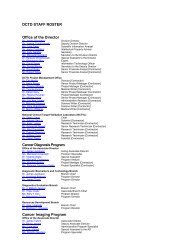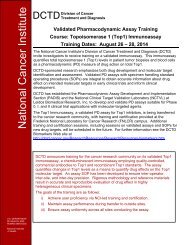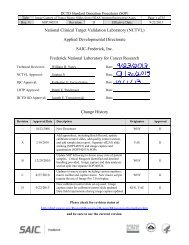National Cancer Institute - NCI Division of Cancer Treatment and ...
National Cancer Institute - NCI Division of Cancer Treatment and ...
National Cancer Institute - NCI Division of Cancer Treatment and ...
Create successful ePaper yourself
Turn your PDF publications into a flip-book with our unique Google optimized e-Paper software.
information is available on DTP’s Website:<br />
http://dtp.nci.nih.gov/docs/misc/<br />
common_files/submit_compounds.html.<br />
In September 2005, DTP’s human tumor<br />
cell line in vitro screening assay was<br />
reviewed by a panel <strong>of</strong> extramural experts.<br />
Because <strong>of</strong> reproducibility issues, DTP’s<br />
st<strong>and</strong>ard operating procedures were evaluated,<br />
<strong>and</strong> a series <strong>of</strong> recommendations<br />
was made to improve quality control.<br />
New Screening Assays<br />
http://spheroid.ncifcrf.gov/STB/<br />
stb_index.cfm<br />
Although <strong>NCI</strong>’s human tumor cell line<br />
screen remains the benchmark, DTP’s<br />
Screening Technologies Branch is developing<br />
<strong>and</strong> operating new in vitro screening<br />
technologies, including high-throughput<br />
molecularly targeted screens, computational<br />
tools for new approaches to data<br />
mining, dynamic data visualization tools,<br />
<strong>and</strong> cell-free biophysical assays <strong>of</strong> macromolecular<br />
interactions.<br />
The branch’s labs <strong>and</strong> <strong>of</strong>fices are located<br />
on the <strong>NCI</strong>-Frederick campus <strong>and</strong> are<br />
operated under a contract with Scientific<br />
Applications International Corporation<br />
(SAIC)–Frederick.<br />
In Vivo Testing<br />
http://dtp.nci.nih.gov/branches/btb/<br />
hfa.html<br />
In 1995, DTP implemented a new way to<br />
test the activity <strong>of</strong> potential anticancer<br />
compounds using cells grown inside<br />
biocompatible hollow fibers. The hollow<br />
fiber assay, developed by Dr. Melinda<br />
Hollingshead, chief <strong>of</strong> DTP’s Biological<br />
Testing Branch, has the ability to provide<br />
quantitative indices <strong>of</strong> drug efficacy in<br />
heterogeneous tumors with minimal<br />
expenditures <strong>of</strong> time <strong>and</strong> materials. This<br />
system currently is being used as the<br />
initial in vivo experience for agents<br />
found to have reproducible activity<br />
in the in vitro anticancer drug screen.<br />
The hollow fiber assay has several advantages<br />
over st<strong>and</strong>ard animal efficacy models.<br />
First, demonstrating that potential<br />
anticancer agents have in vivo efficacy in<br />
one or more animal models <strong>of</strong> neoplastic<br />
<strong>NCI</strong> Visuals Online, Linda Bartlett, photographer.<br />
D E V E L O P M E N T A L T H E R A P E U T I C S P R O G R A M ■ 107










